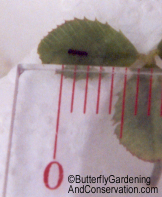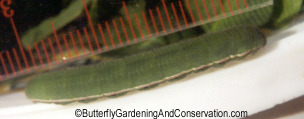|


 | Introduction |
| Introduction |
| Butterfly Gardening |
 Swallowtails
Swallowtails
Sulfurs/Whites
Brushfooted
Little
Snout
 Host
Host
Nectar

T-shirts
Mugs
Magnets
Clocks
Tote Bags
Framed Tiles
Notebooks
Postcards
Light Switch Covers
Tile Coasters
 Books
Books
Web Sites

|

Adult with wings
closed, still hanging
upside down after
having
recently
emerged from
its chrysalis.
Colias eurytheme and Colias philodice are actually two different species of butterflies, or at least
are considered to be two different species by most people. They look a lot alike and even interbreed
at times. I included them together on the same page, because I had difficulty even determining
which of the two I had raised. Their range extends through most of the US, with philodice even being
found in Alaska.
Hosts include many different plants, such as species of Astragalus, Baptisia, Cassia and Trifolium.
I raised several individuals whose eggs I saw being laid on
White Clover - Trifolium repens
growing in our yard.
At first the eggs are a white/cream color and then turn dark when they are closer to hatching.
They are laid singly, and at least in the case of White Clover, laid on the tops of the leaves.
They are oblong shaped and stuck on the leave from one end, although that's hard to see
from these pictures.

|

|
|
These pictures are of eggs that have already turned colors and are close to hatching.
The one on the right is a close up of the same egg on the left.
|

First instar caterpillar.
The method I used to find the eggs
was to follow the female butterfly around the yard keeping my eyes fixed on a spot where
she briefly landed. Then walking to that spot, after she flew away, without taking my eyes off
the spot, then looking carefully at the clover leaves in that area until I find an egg.
I'm not successful 100% of the time, but I do get better with practice.
Females in the process of laying eggs can be spotted by their behavior of landing briefly and
periodically on leaves of plants, as opposed to stopping at flowers to get nectar.
First instar caterpillars are green around 2mm long, typically resting along the middle vein
of the clover leaf. Other early instar stages are also green colored.
These caterpillars do not change their appearance very much as they develop, except for
eventually getting a white stripe that runs along their sides. This makes it difficult
to determine the exact instar of the caterpillar, so I divide them into early, middle
or late instars based on size.

|

|
|
Middle instar caterpillars. Notice the left picture, taken
from the side, that the white stripe show. Also, the rulers all show millimeters, so
you can get an idea of how much growth is taking place.
|

|

|
|
Late instar pictures
|

|
|
Late, probably 5th instar, from above. Notice the dark line running down
its back, its major vein of some sort.
|

|
|
5th instar from the side. If you look closely you can see a little pink
color within the white stripe. In general, in person you can see a lot more detail in the stripe.
All its legs and prolegs can be seen clearly in this picture too. The real legs, 3 on each
side, near its head. The 4 prolegs in the middle part of its body, and the anal prolegs
at the end of its body.
|

A Colias eurytheme/philodice chrysalis.
|

A Colias eurytheme/philodice butterfly that is close to emerging
from its chrysalis. Notice how you can see the coloration of the wings showing
through the chrysalis.
|

Adult Colias eurytheme or philodice butterfly with its wings open.
They don't seem to want to sit with their wings open too much, so its not an easy picture to get.
|

Another view with wings closed, part of the upper wing shows in this
picture.
|
Butterfly Gardening Home |
Butterfly Gardening Articles |
Butterfly Species |
Plants |
Butterfly and Gardening Shopping |
T-shirts |
Mugs |
Magnets |
Clocks |
Tote Bags |
Framed Tiles |
Notebooks |
Postcards |
Light Switch Covers |
Tile Coasters |
Calendars |
Butterfly Calendars |
Resources |
Contact |
Blog |
[old blog] |
© 2003 - 2025 ButterflyGardeningAndConservation.com
Today is: 18 April 2025, 6:10 am |



